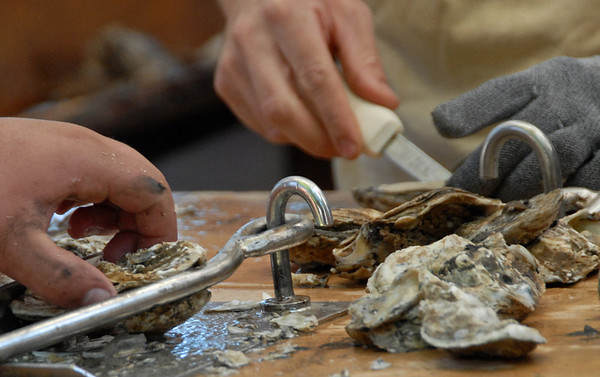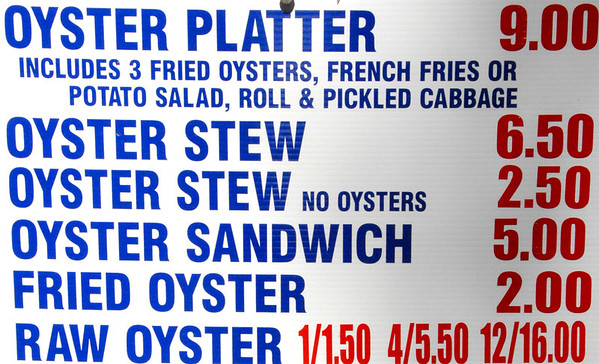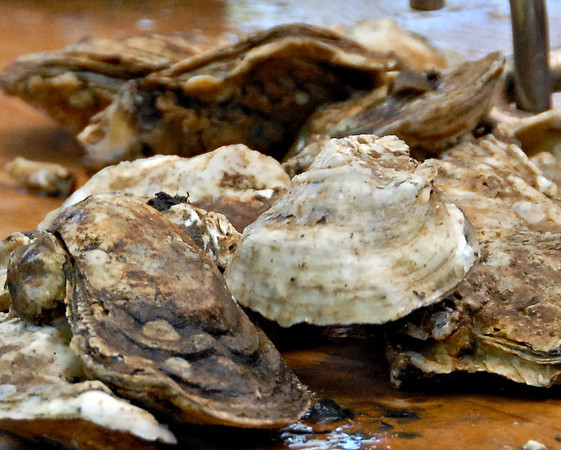 When the invitations to oyster festivals start rolling in, I know that fall is here. Any diehard oyster fan will tell you that during the months of May through August these shellfish spawn, becoming watery and not terribly tasty. Hence the old rule of not eating oysters in a month without an “r” in its name. Once September kicks into full swing, these guys come back, ready to dazzle diners.
When the invitations to oyster festivals start rolling in, I know that fall is here. Any diehard oyster fan will tell you that during the months of May through August these shellfish spawn, becoming watery and not terribly tasty. Hence the old rule of not eating oysters in a month without an “r” in its name. Once September kicks into full swing, these guys come back, ready to dazzle diners.
Although certainly not the most beautiful of bivalves, these gray, rough-shelled creatures have long held tremendous culinary allure. Considered to be a delicacy and an aphrodisiac, they were over-consumed during the 19th century. This, unsurprisingly, led to shortages. Today both American farmed and wild oysters are abundant, healthy and relatively inexpensive to buy.
 What should you do with a mound of live oysters? Like their bivalve brethren, they do well when baked, broiled, grilled, or steamed. They also can be poached, roasted, or sautéed. As evidenced by the event menu above, they’re quite popular when fried, made into a stew or consumed raw on the half shell. High in omega-three fatty acids and iron, they’re likewise low in calories and fat. Talk about a good treat!
What should you do with a mound of live oysters? Like their bivalve brethren, they do well when baked, broiled, grilled, or steamed. They also can be poached, roasted, or sautéed. As evidenced by the event menu above, they’re quite popular when fried, made into a stew or consumed raw on the half shell. High in omega-three fatty acids and iron, they’re likewise low in calories and fat. Talk about a good treat!
 Being faced with counter covered in live oysters can be a bit intimidating. Recently I watched first-time shuckers clumsily pry open shell after sharp, jagged shell. Each time someone placed an oyster in the palm of one bare hand and a paring knife in the other, I imagined the imminent ER trip. If you don’t want to risk stabbing yourself or severing a finger, you can always buy pre-shucked oysters. Before taking them home, check to see that the liquid in their container appears clear. You can also find canned, frozen and smoked oysters in grocery, gourmet, and seafood stores.
Being faced with counter covered in live oysters can be a bit intimidating. Recently I watched first-time shuckers clumsily pry open shell after sharp, jagged shell. Each time someone placed an oyster in the palm of one bare hand and a paring knife in the other, I imagined the imminent ER trip. If you don’t want to risk stabbing yourself or severing a finger, you can always buy pre-shucked oysters. Before taking them home, check to see that the liquid in their container appears clear. You can also find canned, frozen and smoked oysters in grocery, gourmet, and seafood stores.
If you’d like to learn more about oysters and other fish and shellfish, I’ll be teaching a seafood cooking at class at Hockessin, Del.’s Everything but the Kitchen Sink on Wednesday September 25 and at the Sur la Table in King of Prussia, Pa. on Thursday October 17. Details about both events are available by clicking on the bolded links, on the Kitchen Kat events page and at FishMarketBook.com.
OYSTER AND POTATO STEW
Serves 6
3 tablespoons unsalted butter
1 cup minced yellow onion
1/2 cup minced celery
1 pound baking potatoes, washed, skinned and diced
2 cups whole milk
3/4 teaspoon salt
1/4 teaspoon ground black pepper
1 clove garlic, minced
2 dozen oysters, shucked and drained and with their liquid reserved
In a small stockpot melt the butter. Add the onions and celery and sauté until softened and almost translucent, about 5 to 7 minutes. Add the potatoes, stir and allow the mixture to cook for 5 minutes. Add the milk, salt, white pepper and reserved oyster juices and bring to a boil.
Reduce the heat to low and simmer until the potatoes have softened slightly. Skim off any fat that has collected on the top.
Add the garlic, oysters and cook until the oysters’ edges begin to curl, about 4 minutes. Taste and adjust the seasonings if necessary. Serve in warmed bowls with oyster crackers